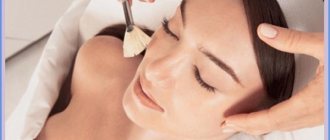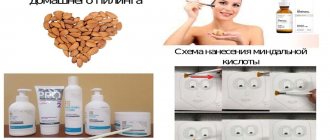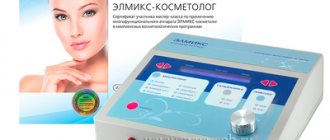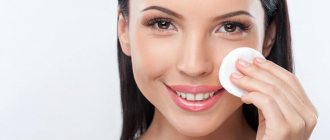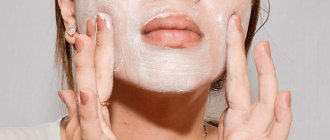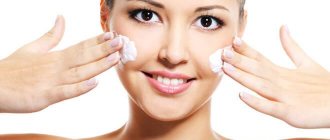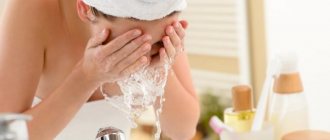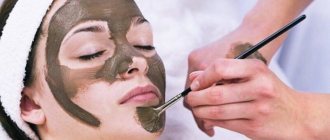Glycolic peeling at home is actively used in cosmetology to rejuvenate facial skin, improve its condition and get rid of a number of problems. Anyone can do peeling at home. They activate cell regeneration and slow down aging as much as possible. Anyone can perform the procedure, which is why it is popular among girls.
Stages
Any chemical exposure must consist of three stages:
- Preparation before peeling. The rationality of the procedure must be determined by a cosmetologist; he also pays attention to the degree of exposure to the components, determines how susceptible the skin is to aggressive components, and eliminates contraindications.
- The exfoliation itself. It is recommended that the peeling be applied by a cosmetologist, taking the necessary precautions, but every girl can carry out the rejuvenation process at home. The duration is from 5 to 15 minutes. In between rejuvenation and improvement of the condition of the epidermis, it is recommended to use cosmetics with a minimum content of aggressive components for maximum effectiveness.
- After application. The cosmetic procedure will not disrupt the girl’s usual rhythm of life. It is enough to apply moisturizers and cream with SPF 30. For two weeks after applying the product, it is better to avoid aggressive exposure to the sun; it is forbidden to visit the solarium and collagenarium. Competent pre-peeling preparation and necessary care after applying the product will ensure the desired result.
Skin care after procedures
Next, the skin needs a mask after glycolic facial peeling. It should moisturize and soothe the inflamed dermis. After the mask, apply a moisturizing cream. You will have to give up decorative cosmetics. It can be used no earlier than after 3 days, if the skin condition is stabilized.
During the first 3 post-peeling days, the skin of the face should be regularly moisturized. Use masks and creams for this. Good results are achieved by soothing compresses made from natural ingredients, for example, decoctions of medicinal herbs: green tea, celandine, etc.
Methods of carrying out
14 days before the scheduled date, visit a cosmetology office and consult with a cosmetologist. You can buy a peeling kit. It contains aggressive particles, a restorative, moisturizing cream. After all the purchases, you will restore and rejuvenate your face on your own. Anyone can do this at home.
Exfoliation is a popular procedure among young and mature women. Use products with low levels of aggressive ingredients. The concentration of active substances increases with each session. After a month, they must be brought to the maximum point, which is determined by the cosmetologist.
Exfoliation takes a few minutes. With each subsequent application, the session time increases proportionally. This is the most effective method. With this approach, you need to be prepared not only for a good result, but also for possible redness and peeling. Do not neglect the rules for applying the product, otherwise you can spend much more money on restoring the epidermis.
Step-by-step instruction
Before application, the skin is disinfected and cleansed with lotions. The drug is applied with a brush, starting from the frontal area to the chin. You can additionally treat the neck and décolleté area.
During exfoliation, you may feel a slight burning or tingling sensation. If it becomes uncomfortable, then the session must be stopped and the face thoroughly cleansed. It is necessary to monitor chemical processes. If redness or swelling appears during the session, the product is removed from this area. If there are several such zones, peeling is contraindicated.
Afterwards, the face is cleaned with a damp cloth and then a product is applied to neutralize dangerous compounds. It is also necessary to apply a cream that protects against UV light. After using acids, there may be minor redness and flaking on the face, which should disappear after a few days. After exfoliation, it is necessary to use sunscreen, because as a result of chemical exposure, it has become more vulnerable to the UV factor.
Peeling is applied in a course of 4-10 sessions with a break of several weeks. The interval between courses should be maximum for recovery. During breaks, use products with a low content of aggressive compounds to achieve the effect.
How is the glycolic peel procedure performed?
Due to its gentle and gentle action, glycolic peeling for the neck and décolleté requires mandatory pre-peeling preparation. The client begins the initial stage of the peeling itself (preparation for it) independently, at home, using the means recommended by the cosmetologist. Typically, this preparation lasts from ten days to two weeks. It consists of using a special serum and cream, which contain a small percentage of glycolic acid. These products are applied to the skin daily in the morning and evening. In addition to serum and cream, even in the winter season, the use of sunscreen will be mandatory. The day before peeling, pre-peeling preparation should be stopped.
The procedure for peeling the neck and décolleté will not differ much from a similar procedure on the skin of the face. After thorough cleaning, a degreasing agent is applied. After the skin is thoroughly dried, it is the turn of the glycolic acid itself. It is applied with a thin brush, starting from the least tender and sensitive areas. The acid exposure time on the skin is determined visually, depending on the skin reaction. In the first procedure it can be 1-3 minutes. After the allotted time has elapsed, a neutralizing solution is applied to the skin, and then everything is thoroughly washed off with water. Next, depending on the skin type and indications, the appropriate serum, mask and finishing cream are applied.
The client carries out post-peeling care at home independently. The stages and means of this care are prescribed individually. The general thing is that the use of sunscreen and moisturizer will be mandatory. As after any peeling, the skin will require especially delicate handling: after washing, the skin can only be blotted and you should not “help” the peeling, as this is fraught with the formation of scars.
Glycolic chemical peeling of the neck and décolleté has all the same contraindications as any other (the cosmetologist should inform the client about them). Often, to achieve the best results, peelings are carried out in courses of 6 to 10 times. The frequency of procedures depends on the indications and the concentration of glycolic acid and can be from once a week to one procedure per month.
How to prepare a glycolic peel at home
An exfoliation kit can be purchased from a cosmetologist or a specialty store. The procedure at home deprives you of professional advice from a master. The rationality of the experiment has not been proven (if you have never visited a cosmetologist and are not sure of a positive skin reaction).
The stages of implementation should include pre-peeling preparation of the face with a professional product. Then apply the mixture liberally to your face, avoiding the area around the eyes. In this area, the epidermis is quite vulnerable, and the ingress of dangerous particles can cause irritability and dryness.
Peeling must be kept for 5-15 minutes. Then thoroughly cleanse your face with water (chamomile decoction) and apply a special lotion. If after applying the cream you still feel the tingling sensation, you should wash your skin further and do not apply any more products at home. Be sure to study the contraindications. If you follow the course of application, the skin will be as well-groomed and fresh as possible, and the aging process will slow down significantly.
Glycolic peeling recipe
The acid used for exfoliation is a natural alpha hydroxy acid (AHA) derived from fruits and sugar canes. When applied to the skin, it creates a subtle chemical exfoliant that can clear away dead skin cells. A course of procedures will significantly reduce wrinkles, even out skin texture and color, restore hyaluronate production, and stimulate cell restoration and renewal.
Aggressive particles in cosmetology are also used to treat rashes and problematic skin by gently drying it, thoroughly cleansing the sweat glands, and restoring the functioning of the sebaceous glands.
Peeling is freely available on the market, in addition, instead of the chemical component, you can use cane sucrose, which is considered a gentle substitute for chemicals and is suitable for very dry skin.
Recipe with natural ingredients
You will need 62 grams of cane sucrose, lemon juice, which will significantly increase the effectiveness of aggressive compounds. Apply the mixture evenly to the skin in a circular motion, avoiding dangerous areas. Session duration is up to ten minutes. Rinse off any remaining sugar with water and apply cream. An alternative to the ingredients is pineapple puree.
Fruit acids perfectly complement dairy acids. Take cane sugar and yogurt in different quantities. Mix the ingredients thoroughly to form a granular paste. Apply the mixture to your face, avoiding dangerous areas. Leave for 5-15 minutes, rinse with warm water, apply moisturizer.
Types of glycolic peeling
There are two main types of exfoliation:
- superficial;
- median.
The surface mask is applied using a composition of acid concentrations up to forty percent; glycolic acid 12% or 30% is acceptable. In this case, the pH level cannot be more than 4.5 (from 2.4). This composition evens out the tone, eliminates problem areas, and eliminates oiliness or dryness. The impact is on the first ball of the cover. The maximum effectiveness of the procedure helps to prepare for an important event, going out in a short time.
Medium peeling is carried out in the salon, so the concentration of acids is much more aggressive - from forty to seventy percent. The Ph level in this composition for the procedure is insignificant - up to 2.8. This type affects not only the upper ball of the integument, but also the middle balls, preventing more serious problems - minor folds, acne marks, pigmentation, unevenness.
Glycol peeling can be neutralized with an alkaline composition, which will make the peeling more gentle. It is recommended to rinse off the product with cool water and baking soda. Then it is possible to apply saline solution to the skin.
Contraindications to chemical peeling
You should avoid using this cleansing method if you have the following diseases or conditions of the body:
- Aggravated phase of acne or acne.
- Individual intolerance to one of the components of the composition.
- Active phase of herpes.
- The presence of inflammatory processes in the treated area.
- High skin sensitivity.
- Diseases of the heart and blood vessels.
- Mental abnormalities.
- Pregnancy and lactation period.
- High body temperature.
- During menstruation.
- For rosacea.
- Deviations in the functioning of the thyroid gland.
Neutralization of acids is a mandatory step
Acids must be neutralized when the required depth of penetration is reached, otherwise the acids will not penetrate as deeply, which will lead to negative results. Neutralization is performed with any product with a classic pH (for example, soda or plain, salted water). You can apply the neutralizing composition with a cotton pad to those areas where the composition needs to be neutralized initially, and then apply to the skin. Afterwards the composition is washed off with plain water.
The depth of impact directly depends on the time of application. If acids are left on the skin for long, the wounds can be fatal. Therefore, glycolic acids are applied for a strictly described time. The developers of the method have proven that effective results can be achieved with acids of lower concentration if combined with ultrasonic exposure.
Advantages and features of glycolic peeling
Glycolic peeling has established itself as the safest and most painless method of skin rejuvenation. Thanks to the special components included in the peeling solution, even a 70% concentration of glycolic acid is completely safe for the skin. They are responsible for the penetration of active substances into the skin to the required depth. Ingredients developed using the latest technologies today make it possible to perform active glycolic peeling, because they block the patient’s perception of sensitive receptors. Therefore, during the session the patient feels quite comfortable: he does not feel itching, irritation or swelling, but only a slight tingling of the skin.

